Today’s recipe, Kansai-style Ozōni (Miso Soup with Rice Cake), should have been posted a bit earlier because Ozōni is usually eaten on the first 3 days of the new year as part of the New Year’s feast. But there is no reason why you can’t make it all year round. Today’s Ozōni is a Kansai (Western region of Japan) style and it comes in a miso-flavoured soup.
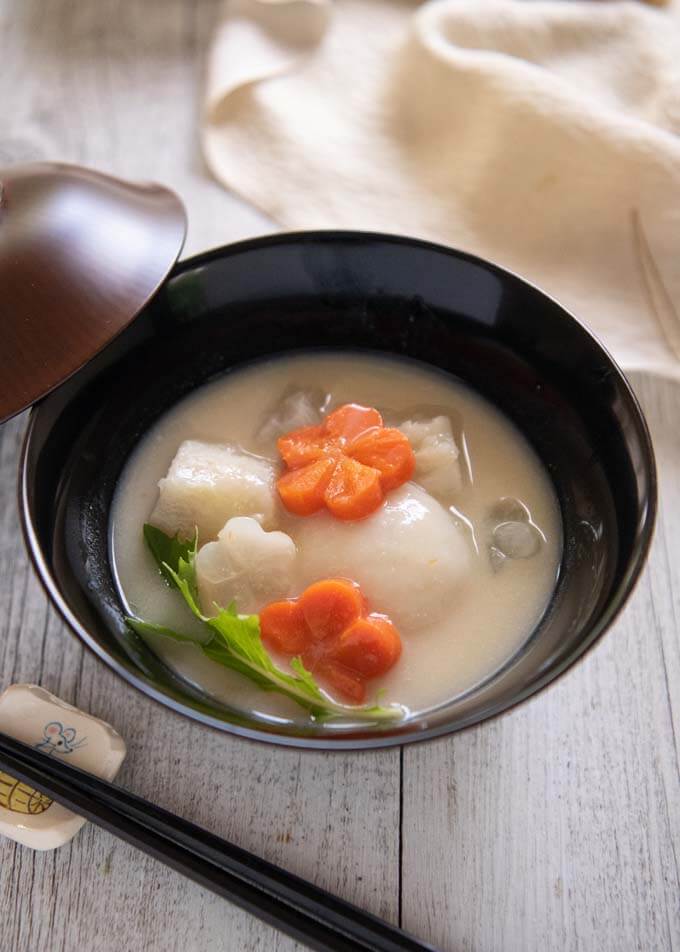
I posted a Kantō (Eastern region of Japan) style Ozōni a long time ago. I thought it would be good to introduce you to a quite different Ozōni in the Kansai style as well, so that you can compare the two versions.
Origin of Ozōni
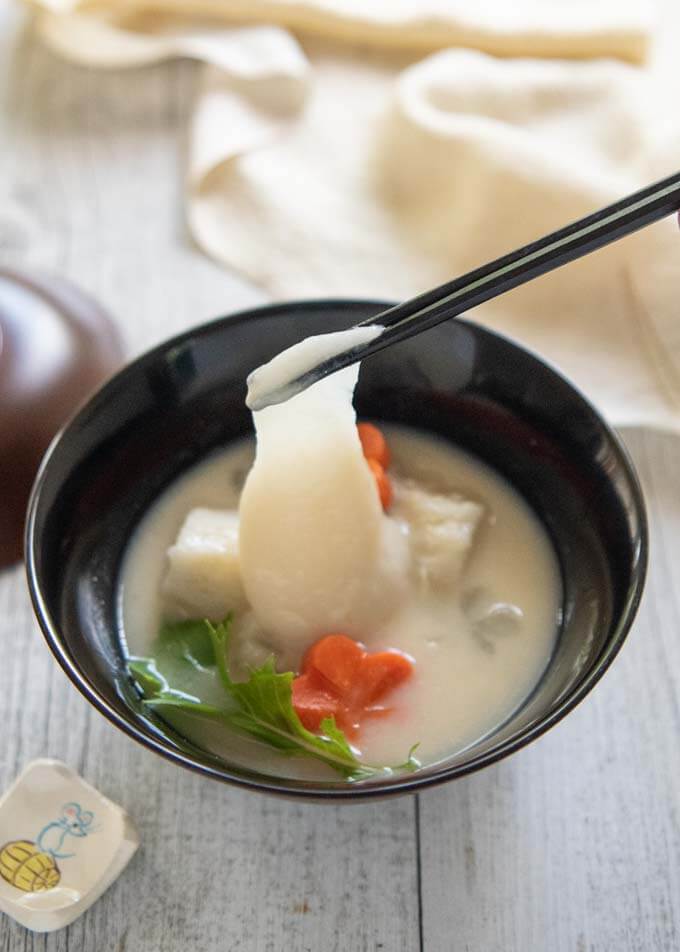
Ozōni has a very long history. It originated in the Heian period (794-1885). At the time, rice cake (‘mochi’ 餅) was a celebratory food only to be eaten on special occasions.
On the very first day of the year, people drew water from the well for the first time in the new year, then cooked the rice cakes and vegetables on the fire that was lit for the first time in the new year.
The name of the dish, ‘ozōni’ (お雑煮), came from how the vegetables and rice cakes are cooked together. Cooking various ingredients together is called ‘nimaze’ (煮雑) and the Kanji characters were swapped to read ‘zōni’. ‘O’ is a prefix used to add a feeling of politeness or respect.
Difference between Kansai Style and Kantō Style Ozōni
I can list several notable differences between the two types of Ozōni.
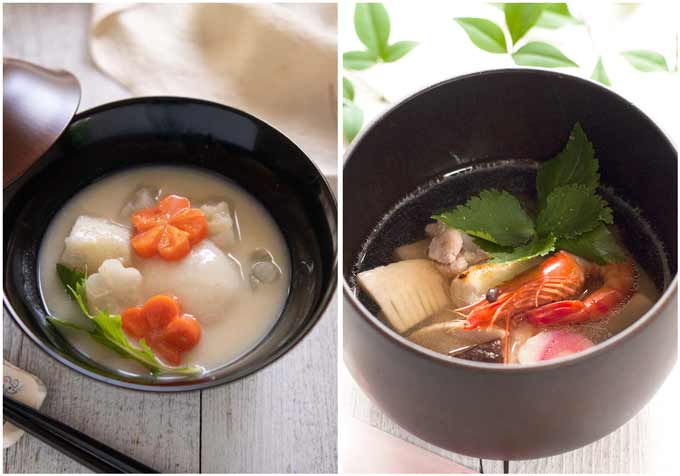
Kansai style (left photo above):
- Soup – white sweet miso soup
- Rice cake – round
- Cooking rice cake – cook in the broth
- Vegetables – usually carrot, daikon, and taro
- Meat/seafood – not included
Kantō style (right photo above):
- Soup – clear soup
- Rice cake – square
- Cooking rice cake – grill before putting in the soup
- Vegetables – shiitake mushrooms, carrot, and/or bamboo shoot
- Meet/seafood – chicken, kamaboko (fish paste), and/or prawns
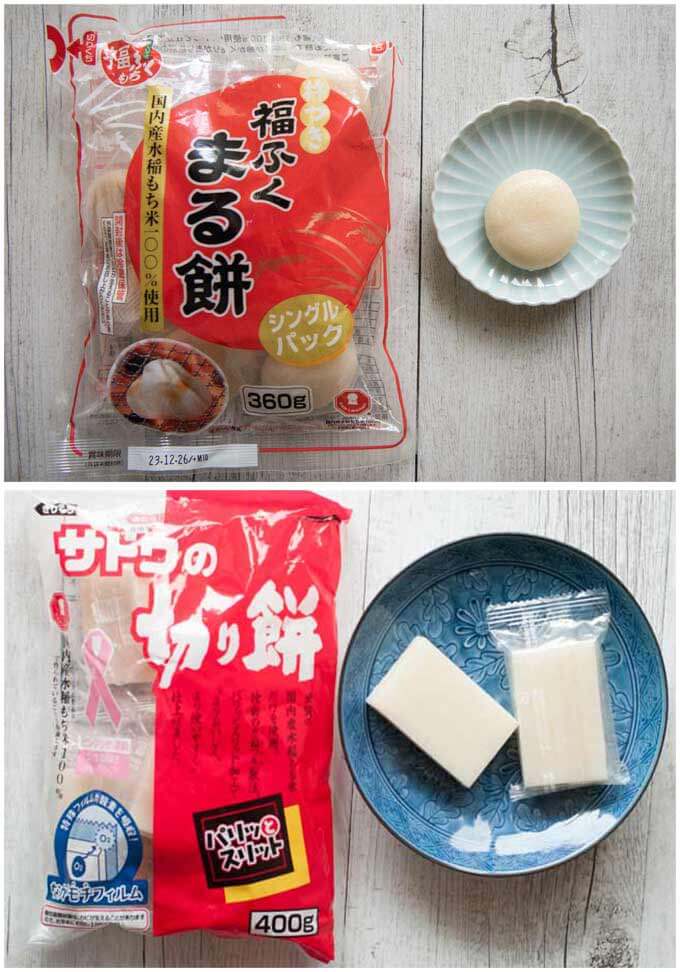
There are variations as always, and each household may use slightly different vegetables and meat/seafood. But I think that the soup and the shape of the rice cake distinguish the Kansai style and the Kantō style.
What’s in my Kansai Style Ozōni (Miso Soup with Rice Cake)
- Round rice cakes
- Sliced carrot
- Sliced daikon
- Small taro
- Dashi stock
- Sweet shiro miso such as Saikyo miso
- Blanched mitsuba, mizuna, or spinach as a garnish
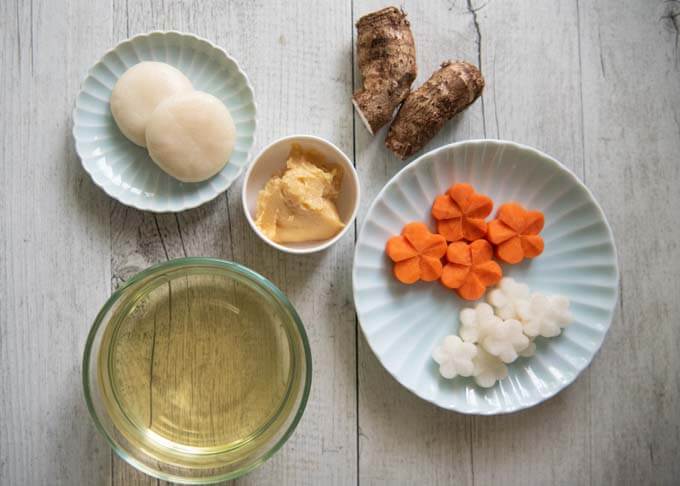
You may not be able to find round rice cakes at Japanese/Asian grocery stores because rectangle ones are more commonly available. If you can’t find round rice cakes, use rectangle ones.
I made flowers with carrot and daikon for a better presentation, but this is optional.
If you use a normal shiro miso (not sweet shiro miso), the soup might look similar in colour, but the flavour will be quite different. It will be much saltier and lack sweetness.
How to Make Kansai Style Ozōni (Miso Soup with Rice Cake)
Compared to the Kanto style Ozōni, Kansai style is much simpler to make.
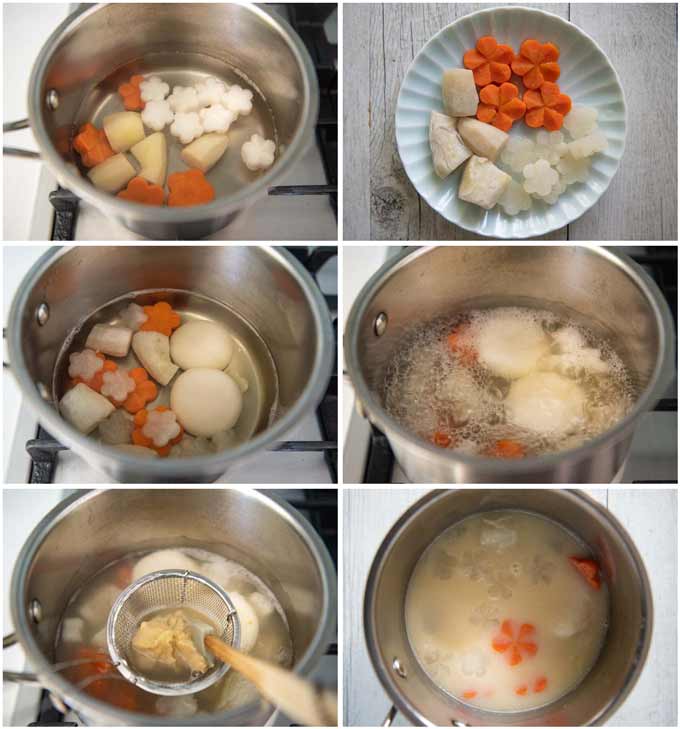
- Cut vegetables and boil them until almost tender.
- Cook vegetables and rice cakes in dashi stock.
- Add miso to the broth and dilute it.
- Serve with a garnish if using.
If you have time, I would strongly recommend that you put in an extra effort to shape the sliced carrot and daikon into flowers. Flower-shaped vegetables are perfect for a happy occasion.
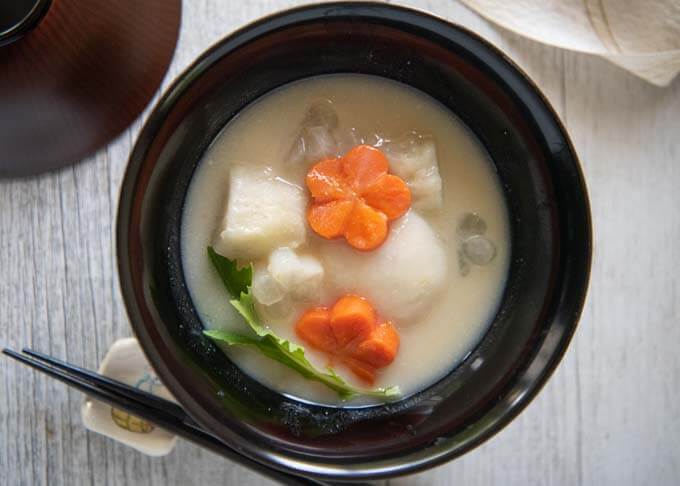
I didn’t add a Meal Idea section today. My suggestion is to have today’s Ozōni with any combination of the dishes that I listed in the Meal Idea section of the post Tazukuri (Candied Baby Sardines).
Yumiko![]()
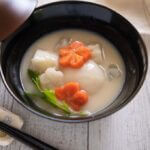
Ozōni is usually eaten on the first 3 days of the new year as part of the New Year’s feast. Unlike the Kanto style (Eastern region of Japan) Ozōni that I posted quite some time ago, today’s Ozōni is a miso-based soup. It is basically a sweet white miso soup with a round rice cake in it.
- 2 round rice cakes (30g/1.1oz each, note 1)
- 35-40g/1.2-1.4oz carrot sliced into 8mm/5⁄16" thick discs (note 2)
- 35-40g/1.2-1.4oz daikon sliced into 8mm/5⁄16" thick discs (note 2)
- 2 small taro peeled (about 30g/1.1oz each after peeled)
- 350ml/11.8fl oz dashi stock
- 50g/1.8oz Saikyo miso (or sweet shiro miso)
- Mitsuba or mizuna leaves, spinach (blanched, note 3)
-
Halve each taro horizontally so that the size of the taro is similar to other vegetables.
-
Put carrot, daikon, and taro in a pot with water and bring it to a boil.
-
Boil vegetables until they are almost tender (it took about 8 minutes) and drain (note 4).
-
Put the vegetables, rice cakes and dashi stock in a pot and bring it to a boil.
-
Reduce the heat to medium and cook for about 2-3 minutes until the rice cake becomes soft in the centre.
-
Using a small sieve, dilute the miso into the broth (note 5).
-
When the soup starts boiling again, turn the heat off.
-
Serve 1 rice cake, two slices each of carrot and daikon, two pieces of taro in a serving bowl with the miso soup. Place mizuna leaves if using.
1. Kansai (the Western region of Japan) style Ozōni uses round rice cake (see the sample photo in the post), which you can buy at some Japanese grocery stores. If you can’t find round rice cakes, you can use square rice cakes instead.
2. If you have a flower-shaped vegetable cutter, cut carrot and daikon slices into flower shapes.
You can make a flower shape with a knife as well. Please refer to Note 2 in the Sanshoku Bentō recipe card.
If you have time, you can make a 3-D flower shape called ‘nejiri ume’ like my carrot and daikon in the photo. I explained how to make it in my post Simmered Vegetables (Nishime). I used a small cutter for daikon and a large cutter for carrot.
If you are making nejiri ume, slice the vegetables into 1cm/⅜" thick discs.
3. Mitsuba is the traditional garnish for Ozōni, but I used mizuna leaves as I could not find mitsuba.
4. Each vegetable piece might require different time to cook, so check occasionally and remove the vegetables from the pot if they are ready and the others need more time to cook.
5. Instead of using a sieve, you can use a ladle and chopsticks. Put the miso in a ladle, then lower the ladle into the broth gently until a small amount of broth flows into the ladle. Use chopsticks to dilute the miso in the ladle.
6. Nutrition per serving.
serving: 292g calories: 216kcal fat: 4g (6%) saturated fat: 1.8g (9%) trans fat: 0g polyunsaturated fat: 0.8g monounsaturated fat: 0.7g cholesterol: 3mg (1%) sodium: 895mg (37%) potassium: 606mg (17%) carbohydrates: 39g (11%) dietary fibre: 3.9g (16%) sugar: 20.0g protein: 7.5g vitamin a: 59% vitamin c: 11% calcium: 4% iron: 8%
Can you please share where you bought the vegetable cutter from?
Hi Anna, I bought them at Daiso (discount shop) in Sydney. I there is Daiso in your country. You might also find the cutters at Japanese grocery stores and online shops. Google search on ‘decorative vegetable cutter’ to see what comes up. There are large flower shape and small flower shape.
How do you make those pretty flowers out of carrots?
Hi Linda, in note 2 of my recipe card, I referred to a couple of posts that let you make these flowers. The first site, Sanshoku Bentō, explains how to make a flat flower-shaped carrot using a knife (in case you don’t have a flower-shaped cutter). The second site, Nishime, shows you how to make a 3D flowers from the flat flower-shaped carrot within the post as well as in the note section of the recipe card.
Love the history and tradition… lovely soup
Thank you, Agnes!
Happy New Year from Canada
This soup bowl is so beautiful with the lovely flowers of carrot and daikon
What a nice way to welcome the New Year
Hi Judy, Happy New Year! I hope where you live is not severely impacted by the snow.
Soon after the New Year, around February, plum flowers start blooming in Japan. So, nejiriume which means twisted plum flowers, is so timely.